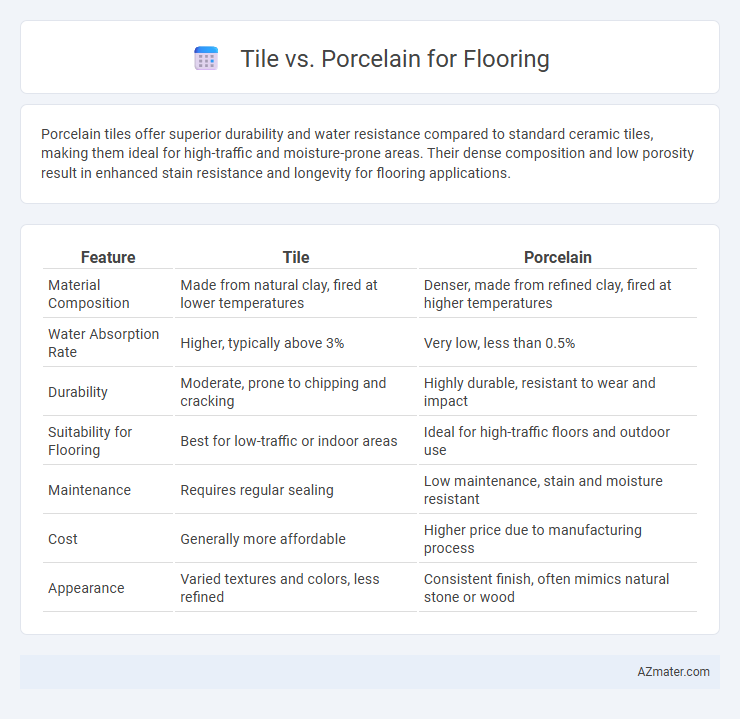Porcelain tiles offer superior durability and water resistance compared to standard ceramic tiles, making them ideal for high-traffic and moisture-prone areas. Their dense composition and low porosity result in enhanced stain resistance and longevity for flooring applications.
Table of Comparison
| Feature | Tile | Porcelain |
|---|---|---|
| Material Composition | Made from natural clay, fired at lower temperatures | Denser, made from refined clay, fired at higher temperatures |
| Water Absorption Rate | Higher, typically above 3% | Very low, less than 0.5% |
| Durability | Moderate, prone to chipping and cracking | Highly durable, resistant to wear and impact |
| Suitability for Flooring | Best for low-traffic or indoor areas | Ideal for high-traffic floors and outdoor use |
| Maintenance | Requires regular sealing | Low maintenance, stain and moisture resistant |
| Cost | Generally more affordable | Higher price due to manufacturing process |
| Appearance | Varied textures and colors, less refined | Consistent finish, often mimics natural stone or wood |
Introduction: Choosing the Right Flooring Material
Tile and porcelain flooring are popular choices for durability and aesthetic appeal, each offering distinct advantages. Porcelain is denser and less porous than ceramic tile, making it more resistant to moisture, stains, and wear, ideal for high-traffic or wet areas. Selecting between tile and porcelain depends on factors such as budget, maintenance requirements, design preferences, and the specific environment where the flooring will be installed.
Tile vs Porcelain: What’s the Difference?
Tile and porcelain differ primarily in composition and durability; porcelain is a type of ceramic tile made from finer, denser clay fired at higher temperatures, resulting in superior strength and lower water absorption rates. Porcelain flooring is more resistant to scratches, stains, and moisture, making it ideal for high-traffic or wet areas, whereas ceramic tile is more affordable and easier to cut but less durable. Understanding these differences helps homeowners select the best flooring material for specific needs and environments.
Durability and Strength Comparison
Porcelain tiles exhibit higher durability and strength compared to standard ceramic tiles due to their denser composition and lower water absorption rate, typically less than 0.5%, making them ideal for high-traffic areas. The hardness of porcelain tiles, rated around 7 on the Mohs scale, surpasses that of ceramic tiles, which generally range between 5 and 6, resulting in enhanced resistance to scratches and cracks. Porcelain's resilience to moisture, stains, and heavy impact contributes to a longer lifespan and reduced maintenance needs in both residential and commercial flooring applications.
Water Resistance and Moisture Protection
Porcelain tiles offer superior water resistance compared to regular ceramic tiles due to their dense, non-porous composition, making them ideal for moisture-prone areas like bathrooms and kitchens. The low water absorption rate of porcelain tiles, typically below 0.5%, ensures enhanced durability and prevents mold or mildew growth under constant humidity exposure. While ceramic tiles provide decent moisture protection, porcelain's structural properties deliver better long-term performance in wet environments.
Design, Colors, and Style Options
Porcelain tiles offer a wider range of design options due to advanced manufacturing techniques, allowing for realistic wood, stone, and concrete finishes with high durability. Tile flooring includes ceramic, quarry, and natural stone varieties, providing diverse color palettes and textures that can complement traditional to modern styles. Both materials support versatile installations like mosaics and large-format layouts, enhancing aesthetic flexibility for residential and commercial spaces.
Installation Process and Complexity
Porcelain tile installation requires precise cutting and specialized tools due to its density and hardness, making the process more complex and time-consuming compared to ceramic tile. Ceramic tiles are more forgiving during installation, easier to cut, and generally lighter, allowing for quicker placement and adjustments. Both options demand proper subfloor preparation and thin-set mortar application, but porcelain's durability necessitates professional expertise to ensure long-term performance and avoid cracking.
Maintenance and Cleaning Requirements
Porcelain flooring requires less maintenance than traditional ceramic tile due to its dense, low-porosity surface that resists stains and moisture. Regular cleaning for porcelain involves sweeping and mopping with a mild detergent, minimizing the need for sealants or special cleaners. Ceramic tiles often need more frequent sealing and grout maintenance to prevent discoloration and damage from water exposure.
Cost Analysis: Tile vs Porcelain Flooring
Porcelain flooring typically costs more upfront than ceramic tile due to its denser material and enhanced durability, often ranging from $5 to $15 per square foot compared to tile's $1 to $10 range. Installation expenses for porcelain are higher because it requires specialized tools and skilled labor, increasing overall project costs by approximately 10% to 20%. Long-term maintenance savings with porcelain arise from its superior resistance to moisture, stains, and wear, potentially lowering repair and replacement expenses over time.
Best Applications for Each Material
Porcelain flooring excels in high-traffic and moisture-prone areas such as bathrooms, kitchens, and outdoor spaces due to its superior density, low porosity, and durability. Ceramic tile is ideal for low to moderate traffic areas like living rooms and bedrooms, offering a wide variety of styles and easier installation at a lower cost. Choosing between tile and porcelain depends on specific application needs, with porcelain favored for heavy use and moisture resistance, while ceramic is suitable for decorative and budget-conscious flooring solutions.
Conclusion: Which Flooring Option is Best for You?
Porcelain flooring offers superior durability, water resistance, and low maintenance, making it ideal for high-traffic or moisture-prone areas, while ceramic tile provides more affordable options with a wider variety of designs suited for less demanding spaces. Evaluating your budget, lifestyle, and room conditions will help determine the best flooring choice for your home. Prioritizing porcelain ensures long-term performance, whereas ceramic balances cost with aesthetic flexibility.

Infographic: Tile vs Porcelain for Flooring
 azmater.com
azmater.com